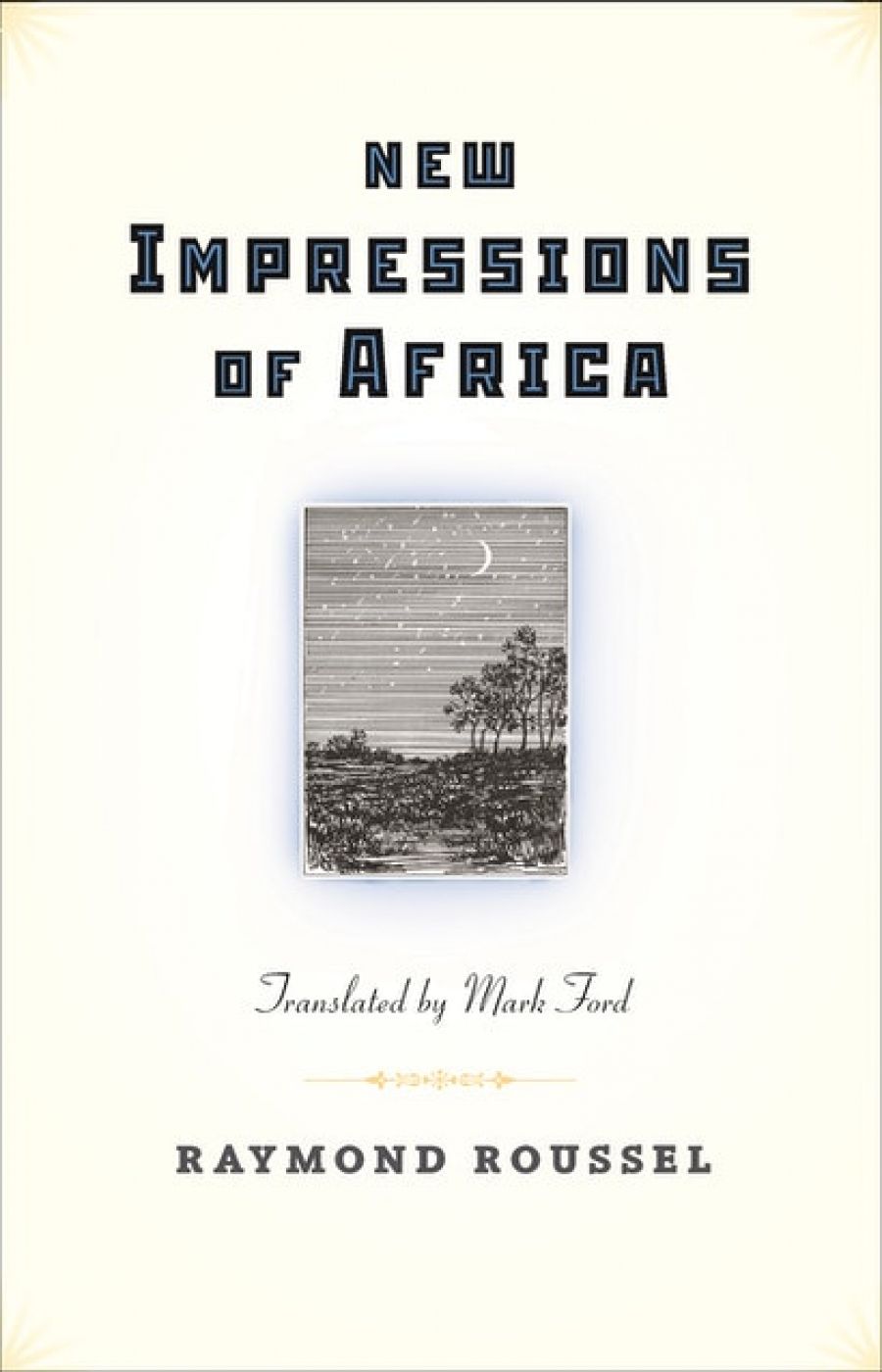
- Free Article: No
- Contents Category: Poetry
- Review Article: Yes
- Article Title: Babushka doll
- Online Only: No
- Custom Highlight Text:
Like all of his earlier books, Raymond Roussel’s final work, New Impressions of Africa, published in 1932, was printed at his personal expense, and only after he was satisfied that the poem was as good as possible. He claimed that each line took fifteen hours to compose. Roussel wanted his work to have enduring importance, and wrote a book entitled How I Wrote Certain of My Books to help readers who might otherwise misunderstand his method (it appeared in 1935, two years after his suicide). Roussel, thanks to his vast inherited wealth, was a writer who answered to no one and nothing, except his own inimitable vision.
- Book 1 Title: New Impressions of Africa
- Book 1 Subtitle: Nouvelles Impressions d’Afrique
- Book 1 Biblio: Footprint Books, $47.95 hb, 253 pp
It is no surprise, then, to discover that New Impressions of Africa, newly translated and introduced by Mark Ford, is a most unusual book. Salvador Dalí called it one of the most poetically elusive works of his time. The poem has none of the scenic qualities that its title might suggest; in fact, the narrator pays little attention to the world around him (though he is indeed in Africa). In each canto, Roussel moves quickly from the sights of Egypt to a more exciting area of exploration, his narrator’s mind, and then back briefly to Egypt. The technique he employs each time, in order to get away with this hasty change of scene, is what makes New Impressions of Africa a bizarre and hypnotic poem.
In order to describe this technique, the most striking aspect of the poem needs to be noted: each of the cantos is defined by the parentheses that subdivide it. Each parenthesis contains another parenthesis, the effect of which is that each canto resembles a set of linguistic babushka dolls. For example, Canto I begins with a description of visiting the place in Egypt, where Louis IX was captured and imprisoned. The narrator is excited, but only until line fourteen, at which point the poem suddenly changes course. The sight of an old jail leads him to ponder an old apartment building, which leads, in turn, to the photographer who lives on the third floor, and the lengths people go to in order to look beautiful in photographs. The poem moves deeper into the imagination of the narrator. At each transition, a new parenthesis is opened:
Crow’s feet and spots by clever strata gems –
((Powder of the retoucher! When sporting her jewels,
(((Each person, infatuated by self-love, when he proudly has
Someone take his photograph, keeping as still as he can,
Here, the narrator is imagining a person who wonders whether, if he moves, the photograph that is being taken will blur. At this moment, instead of returning to the scene of the traveller in Egypt, Roussel’s narrator begins to list people in comparable states of wonder to the photographer, such as, ‘The animal tamer if his widow, one year on, without grey or mauve, / Will still be in strict mourning, as a wild beast eats him’. The first of the brackets are closed 216 lines later.
Such a form of poetry might produce different reactions in different readers. To the willing reader, however, the effect is winning. The beginning of the sentence (each canto contains one sentence, with one verb) is quickly lost from sight, and, thus, the Egyptian setting is forgotten. In the middle of each canto, the reader encounters a long, percussive list of outlandish similes. The narrator seems to posses an endless appetite for distraction, and to be capable of exhausting the very idea of analogy. As Ford observes in his introduction, ‘we forget about the poem’s peculiar structure, and are allowed to enjoy in peace the pleasures of the list’. Of course, eventually the lists do end, and the parentheses are closed: such a structure demands that the reader return to the origin, to the syntactic unit that began the canto. A return, from the imaginary, to the real.
Ford has not just translated but has also deciphered the New Impressions of Africa. In his own words, the poem is nothing less than a ‘brain-teaser’. His translation is, as he concedes, less concise than the original, but not by much, and perhaps inevitably so. Roussel is so precise and sharp that his words seem almost psychically ergonomic.
What Ford does brightly is recreate Roussel’s cleverness and wit. In Canto II, as a long list of things that have been mistaken for smaller things unfolds, Ford’s English carefully expresses the strange beauty of mistaking, ‘when there’s not a gust of wind / And snow is falling, a heap of red eggs, / For strawberries being sugared’, and the cruel humour of mistaking, ‘for that which, in love with fashion, / The myopic painfully forces into his eye socket, / A porthole’. As Ford says, Roussel can be very funny, regardless of his complexity. His humour, however, is not subjected to the same regulation that Roussel imposes on his form. Where the form is strict and sober, the humour is ironic and treacherous.
In short, Ford has successfully translated what is nothing less than a sort of charming anomaly of modern literature. Rather than distracting from his work, the explanatory notes encourage the reader to appreciate Roussel. This generous clothbound, bilingual edition, which includes the original illustrations that Roussel commissioned, would even have pleased the author himself.


Comments powered by CComment